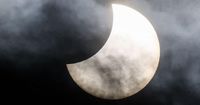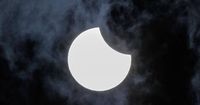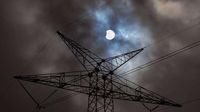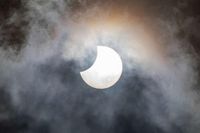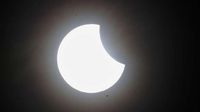On March 29, 2025, a partial solar eclipse captivated viewers across Germany, as the moon positioned itself between the Earth and the sun, partially obscuring the solar disk. This celestial event commenced in the western part of the country and reached its peak between 12:10 PM and 12:20 PM, lasting until approximately 1:00 PM.
The eclipse was visible across Europe, including Greenland, the far northwest of Africa, and Newfoundland. The greatest coverage of the sun was anticipated over Greenland, while in Germany, the moon only slightly obscured the sun, with the maximum coverage observed in the northwest region. Meteorologists had predicted that this area would enjoy the best weather conditions for viewing the phenomenon.
According to Carolin Liefke from the Haus der Astronomie in Heidelberg, the moon's shadow must fall on the Earth for a solar eclipse to occur, which requires a precise alignment of the Earth, moon, and sun. This alignment does not happen every month due to the tilt of the moon's orbit, which is approximately five degrees off from the Earth's orbit around the sun. Consequently, solar eclipses only occur when the new moon crosses the Earth's orbital path.
In the Rhine-Main area, the eclipse's maximum coverage was around 16.5 percent at 12:11 PM. However, the degree of coverage varied significantly across the country. For instance, in Hamburg, the eclipse began at 11:28 AM and reached its maximum at 12:17 PM, covering about 20 percent of the sun. In contrast, cities like Munich only experienced around 10 percent coverage.
As the event unfolded, many people were advised to watch safely. The Federal Office for Radiation Protection emphasized the importance of using special solar eclipse glasses to prevent eye damage when observing the sun. Ordinary sunglasses or other makeshift filters are not safe for direct viewing.
For those who missed the spectacle, the next opportunity to witness a partial solar eclipse in Germany will occur on August 12, 2026, when over 80 percent of the sun will be obscured. The next total solar eclipse visible from Germany will not happen until 2081, making the March 2025 event a rare treat for astronomy enthusiasts.
Experts like Dr. Björn Voss from the Planetarium Hamburg highlighted the significance of this celestial event, noting that the last partial solar eclipse occurred in October 2022. "The further northwest you are, the more impressive the eclipse will be," he explained, with the most substantial coverage expected on Sylt.
Additionally, the eclipse's visibility was not limited to Germany. It was also observable in various parts of Europe, with the best conditions reported in the northern regions. In Potsdam, for instance, the moon began to cover the sun around 11:22 AM, with the maximum obscuration occurring shortly after noon.
For many, the partial solar eclipse offered a chance to connect with the wonders of the universe, despite the risk of cloud cover. Livestreams were made available for those unable to view the event directly due to weather conditions, ensuring that everyone had a chance to experience this astronomical phenomenon.
As the moon's shadow swept across the Earth, the excitement among viewers was palpable. Many gathered at local observatories and parks, equipped with their protective eyewear, to witness the moon appearing to 'nibble' at the sun. The event served as a reminder of the intricate dance of celestial bodies and the beauty of our universe.
In conclusion, the partial solar eclipse on March 29, 2025, was a spectacular event that showcased the wonders of astronomy. With the next partial eclipse on the horizon in 2026 and the total eclipse in 2081, skywatchers in Germany have much to look forward to in the coming years.

